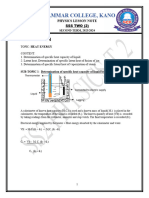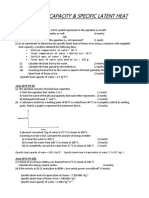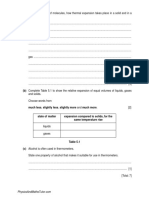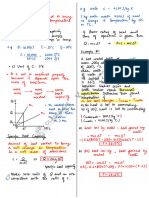0 ratings0% found this document useful (0 votes) 92 views20 pagesPast Paper Questions PHYSICS C
Copyright
© © All Rights Reserved
We take content rights seriously. If you suspect this is your content,
claim it here.
Available Formats
Download as PDF or read online on Scribd
(b) Inn experiment to determine the specific latent heat of fusion of ice, shown in Figure 6,
the following results were obtained.
‘The initial mass of the water is 120 g. The initial temperature of the water is 35 °C and
the initial temperature of the ice is 0 °C.
The final mass of the water is 140 g and the final temperature of the water plus the melted
ice is 18 °C.
te “OR |< Thermometer
Water.
Colorimeter
Figure 6. Experiment to determine the specific latent heat of fusion of ice
Assume the container has negligible heat capacity and that there is no net heat transfer
with the surroundings during the experiment.
(i) Determine the mass of the melted ice.
( mark)
(i) Calculate the heat lost by the water.
G marks)�(ii) Write an expression for the TOTAL heat gained by the ice in melting and the melted
ice in warming to 18 °C.
(2 marks)
(i) Hence calculate the specific latent heat of fusion of ice.
[Specific heat capacity of water = 4.2 J ¢' K"]
G marks)
"Wisinl bane�(a) Define EACH of the following terms:
(Specific heat capacity
G marks)
Gi) Specific latent heat of fusion of ice
G marks)�“9.
(6) A block of ice, which has a mass of 2.5 kg and a temperature of -10 °C, is placed in a
container,
Specific heat capacity of water = 4.2 « 10° J ke (°C)!
Specific heat capacity of ice = 2.1% 10° J kg! (°C)
Specific latent heat of fusion of ice = 3.3 « 10° kg"
Calculate
f the ice at -10 °C to ice at
(i) the heat energy required to change the temperature of the ice at -10 °C to i
orc
(3 marks)
(ii) the heat energy required to convert all the ice at 0°C to water at 0 °C.
i
2 marks)�(c) The water in the container is now heated to a temperature of 80 °C by an electrical heater,
in 600 seconds.
(i) Calculate the power output of the heater.
(3 marks)
(ii) State ONE assumption which must be taken into account in (c) (i).
(1 mark)
Total 15 marks�@) Explain what is meant by the term ‘the specific latent heat of vaporization of water’.
( marks)
Gi) Calculate the heat energy required to convert 8 kg of water at 100 °C to steam at
100 °C.
(Specific Jatent heat of vaporization of water / 1, = 2.300 000 Jkg")
@ marks)�18 Solids, liquids and gases usin, ‘definit
qui ising the terms ‘definite/
Very weak/negligibly weak’, ‘no fixed shape’.
(a) Comy
plete Table 2 to distingui:
ete \guish
fixed’, vibrate’, ‘move freely’, very
TABLE 2
Movement of Intermolecalar
Molecules Forces
Full space
(7 marks)
(b) Students in a fifth form Physics class used the apparatus in Figures 3a and 3b in an
‘experiment to find the specific latent heat of vaporization of water, /,,
Figure 32 shows the initial readings as the water begins to boil and Figure 3b shows readings
taken after 5 minutes and 45 seconds.
Figure 3a, Initial Readings
Figure 3b. Readings after 5 minutes
and 45 seconds�i) Convert Fi
@) the time recorded in igure 3b t
to seconds.
Gi) Calculate the mass of water evaporated in the experiment.
@ marks)
heater used in the experiment was 100 W. Assuming no heat was
(©) The power of the electric
calculate the specific latent heat of vaporization of water, /,.
fost to the surroundings,
(S marks)
Total 15 marks�4 (@) Describe how the apparatus shown in Figure 3 below may be used
to show how the temperature of a substance such as naphthalene,
varies during cooling. Include in your description arly other
equipment that may be necessary.
stirrer ———
>
‘thermometer
naphthalene} oiling tube
TS Figure 3
(b) Ian experiment to determine the specific latent heat of ice, the
following resulis were obtained. 3
Initial mass of water at 30°C = 100 g ;
Final mass of water (initial water plus melted ice) at20°C=110g
<2 aX Ye thermometer
water-
calorimeter:
a Figure 4 :
Assume the container has negligible heat capacity-and that the heat
lost to the surroundings is equal to the heat gained from the *
surroundings during the experiment.
(i) Determine the mass of the melted ice.
(ii) Caleulate the heat lost by the water. (3 marks)
+ Gi) Write down an expression for the TOTAL heat gained by the ice
Le jn melting and the melted ice in one to 20°C. (2 marks)
(1 mark)�= latent heat of fusion of ice. (3 marks)
pecific Heat Capacity of water = 4.2 Jg"K"] :
” Total 15 marks�2. {a) You are provided with the apparatus shown in the labelled
diagram (Figure 2). Describe how you would use this apparets to
determine the specific latent heat of vaporization ofa liquid.
Your account should include the formula (e) and calculation you
would use to arrive at a result and the units in which it would be
expressed,
YS ag = (8 marks)
— ule Water
: Gx ~ SEE ae See
Wingate LILLE eaker
LD. a
Sensitive :
Taldnes ‘ Figure 2�(b) The heeting coil in Figure 2 hes a power rating of 2.0kW.
©
Caiouleie itie time needed to convert 0.25 kg of water initially at 10°C
completely into steam. Assume that heat gained by the beaker and the
environment is ignored.
(Specific heat capacity of: =4.2x107,Jkgt KK. : :
Specific latent heat of vaporization and water = 2.200 x 10°J kg”).
(5 marks)
A bress cube of mass 250 g was heated for 2 few minutes then quickly
red into 2 copper calorimeter of mass 0.065kg which contained 0.12 kg of
Water at 25.0°C. The final eauilibriem temperature of the calorimeter end
is” contents wes 80.0°C.
@ Celeulate the temperature of the brass cube just before it was
trensierred to the calorimeter. ( marks)
@) Een identical lead cube was used with the same temperature as
the brass, would the temperature of the brass be higher or lower
than the lead after heating for the same interval? Justify your
answer.
(Specific heat capacity of brass = 380] kg? K".
Specific heat capecity of water = 4200 Jkg* K".
Specific heet capacity ofcopper = 400 kg? K.
Specific heat capacity oflead = 130Jkg'K").
@ marks)
Total 20 marks�§50 W of solar power is incident on every square metre ofa soler water-
hester collector with length 2 metres and width 1.5 metres. The solar waier-
heater is desimned to heat 120 kg of water which is placed in 2 storage tank
Celcuiate the area of the soler water-heater collector and the power ~
incident on it. (4 marks)
Given that the power incident is sustained for 6 hrs, calculate the energy
input to the solarwater-heater collector. 4 marks}
The solar water-heater collector supplies 18 MJ of energy to the weter
initially at 30°C. Calculate the temperature at which the water is stored.
(4mazks)
Specific heat.capacity of water = 4200 ]Kg"K?
Total 20 marks�(a) i)
¢ Define the term ‘heat capacity"
(2 marks)
Gi) Define the term ‘specific latent heat af vaporization’
(3 marks)
(6) Assubstance which has a freezing point of $0 °C was cooled from 90°C to a total solid at
its freezing point. :
Sketch a graph on Figure 4 to represent the statement above.
‘Temperature/’C
80
‘Timels
Figure 4. Cooling curve
@ marks)�(c)
A student conducted a1
Steam at 100 °C.
(i)
ay
Gi)
i
in experiment in which 1.5 kg of water at 30 °C was converted to
Assuminy
' NO heat is lost to the surroundings, calculate the amount of energy needed to
heat the water from 30°C to 100°C
(4 marks)
convert the water at 100 °C to steam at 100 °C
G marks)
heat the water from 30°C to steam at 100 °C
(i mark)
(Specific heat capacity of water, ¢, ~ 4200 3 kg" K')
ific latent heat of vaporization of water, 1, = 2.3 « 1083 KY
‘Total 15 marks�(i) Define each of the following terms.
6 marks)
(i) Write the formula to show the relationship between the specific heat capacity, c
and heat capacity, C, of a body. ae�) Some students were asked to cary out an experiment to determine the specific heat pacity
a metal. They used the apparatus shown in Figure 5.
Figure 5. Apparatus to determine the specific heat capacity of a metal
“The switch was closed for a time interval of 900 s and the following readings were obtained.
Mass of metal block = 5 kg
Change in temperature = 50 °C
Ammeter reading = 8.5 A
Voltmeter reading = 12 V�stating any
Using the capaci the metal,
4, i apacity of
i data on page 14, calculate the specific heat
ising
assumption(s) made.
(9 marks)
Total 15 marks�b)
(c)
E,
t Loe eel. ee. JEL it T Cat
State, in words, the quantity EACH symbol represents in the equation E,,= mcA@. State
the SI unit of EACH quantity as well.
What does the symbol */’ in the equation E,, = ml represent?
(i mark)
In an experiment to determine the specific latent heat of fusion of ice using a container
with negligible heat capacity, a student obtained the following data:
Initial temperature of water = 30°C
Final temperature of water + melted ice = 20°C
Initial mass of water = 100 g
Final mass of water plus melted ice = 110 g
3) Calculate the heat lost by the water.
(3 marks)�(ii) Calculate the heat gained by the melted ice.
2 marks)
(ii) Assuming the heat lost by the water is equal to the heat gained by the ice, calculate
the specific latent heat of fusion of ice.
@G marks)
[Specific heat capacity of water = 4,2 Jgtk")
Total 15 marks




























































